At the dawn of the common era, the Greek historian and geographer Strabo composed brief descriptions of the numerous tribes living and trading at Eastern Black Sea ports for his encyclopedic work Geographica. Among them, he wrote, “Are the Soanes, who are…superior…in power…and hold possession of the heights of the caucasus above Dioscurias.
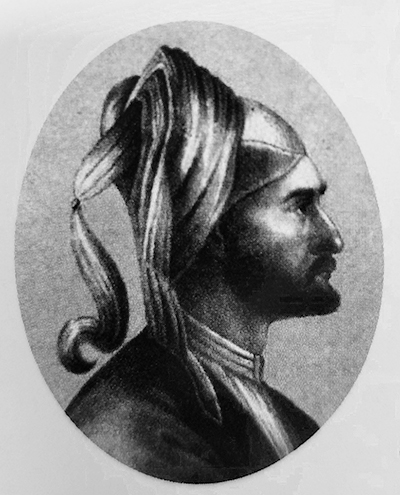
The mountainous locale of the Soanes, east of the trade emporium Dioscurias (modern-day Sukhumi), conveniently matches the Georgian region known as Svaneti, home to a speech community numbering around 35,000 to 40,000 individuals. If Pliny the Elder’s claim (roughly contemporaneous to Strabo’s work) that 130 interpreters were required to do business in Dioscurias is not boldly exaggerated, then it is all the more significant that Strabo chose to mention the Soanes.
Two thousand years later, the Svans are still in the highlands of Georgia, living in the upper valleys of the Inguri and Tskhenis-Tsqali Rivers, in a land of alpine meadows and forests. The Great Caucasus peaks divide Svaneti from its North Caucasus neighbors, Karachay-Circassia and Kabardino-Balkaria, to which passage is possible along a few foot and horse paths. The land in Svaneti is stony and not given to agriculture. Many Svans who live outside the regional capital, Mestia, subsist for most of the year on meat and dairy products, along with local fruits and some corn. Its sublime and pristine landscape, abundant with rare species of flowers and birds, as well as its characteristic koshki or stone towers, has for centuries made Svaneti a destination for mountaineers, naturalists, and other explorers. However, difficult post-Soviet social and economic circumstances, a reputation for lawlessness, and unpaved roads have kept sustained social scientific research there at a minimum until recently.
The Deep History of Svaneti
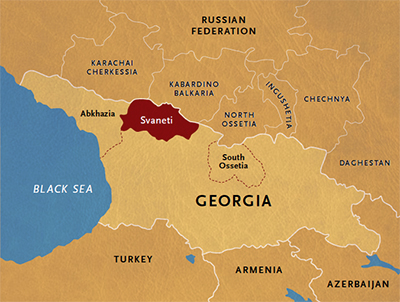
Our research was conducted in the Georgian administrative division of Samegrelo-Zemo Svaneti, the northern half of which is the historical province of Upper Svaneti. Other sites mentioned in the text are also indicated here. As of 2017, South Ossetia and Abkhazia are considered disputed territories.
For all of these reasons, the deep history of Svaneti is mysterious. With little in the way of anthropological or historical research dedicated to the region, much of what is known about Svaneti is linguistic in nature. Svan, the spoken language, is the least similar to the other three living Kartvelian languages, and, as such, is routinely described as being the eldest. Estimated dates for its split from a proto-Kartvelian substrate range from the 2nd millennium BCE to the 3rd millennium BCE, which places it in the time frame for the Kura-Araxes or Trialeti cultures.
The overarching goal of our study was to determine what the patterns of genetic variation in Georgia—placed within archaeological, historical, and linguistic contexts—could tell us about the population history of the South Caucasus.
Svan also has certain linguistic features in common with languages from across the Caucasus range. Both Svan and its North Caucasian neighbors (Abkhaz, Circassian and Kabardino-Circassian, Chechen-Ingush) share basic terms for types of flour and agricultural practice, as well as the name of the goddess of game animals and the hunt. Also noteworthy is the divergence between Svan and its lowland Kartvelian neighbors. Svan shares a mere 360 lexemes (a unit of meaning) with Georgian, and only 340 with Laz and Mingrelian, whereas the latter two share 825 lexemes with Georgian. Based on this comparison, Svan and Georgian are thus said to be as mutually intelligible as English and Icelandic, a fact that may reflect important aspects of Svan population history.
In spite of its linguistic distinctiveness, Svaneti’s official and clerical language from the early Christian period was literary Georgian. The presence of Georgian inscriptions on both the walls of medieval churches and icons, the existence of local schools of art, and the permanent presence of a Svaneti feudal unit in Georgian kingdoms over hundreds of years attests to the cultural synergy between highland and lowland areas. Nevertheless, until the 19th century, most Svans were monolingual and illiterate aside from clergy, migrant laborers, and traders, leading to Svaneti’s reputation as a culturally and linguistically remote area.
Hidden Treasures of the Church
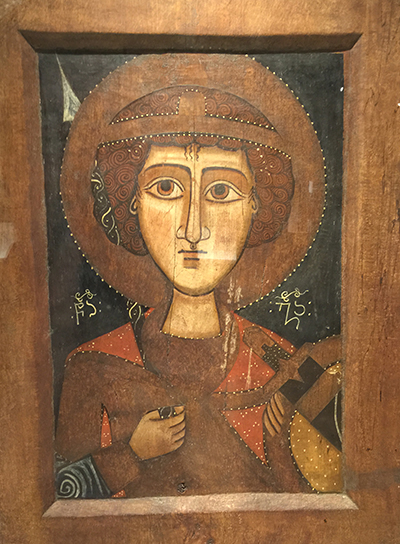
The remoteness of Svaneti made it an ideal place in which to hide the treasures of the Georgian Orthodox Church from invaders. During Mongol incursions into the South Caucasus in the 13th century, for example, Svaneti’s churches served as hiding places for Georgia’s secular and religious artistic heritage, such as icons and illuminated manuscripts, as well as gold and silver items. Some of these objects are still to be found in the churches where they were hidden 700 years ago, while others have been recovered and may be viewed in the National Museum in Mestia.
Svaneti’s isolation has further raised questions about Svan origins and ethnogenesis, although until now these questions have remained unexplored from the point of view of genetics. Thus, the overarching goal of our study was to determine what the patterns of genetic variation in Georgia—placed within archaeological, historical, and linguistic contexts—could tell us about the population history of the South Caucasus. We knew from previous research that there was extremely high paternal genetic diversity in North Caucasus populations, especially those of Daghestan, with long-term and parallel evolution of genes and language in relative isolation (Balanovsky et al. 2011). But what about in the South Caucasus? Did geographically separate populations such as the Svans also exhibit high levels of genetic diversity? With whom do Svans share more biological ancestry— their non-Kartvelian-speaking highland neighbors to the east (Ossetians) and west (Abkhaz) or their Kartvelian-speaking lowland neighbors (Georgians) to the south?
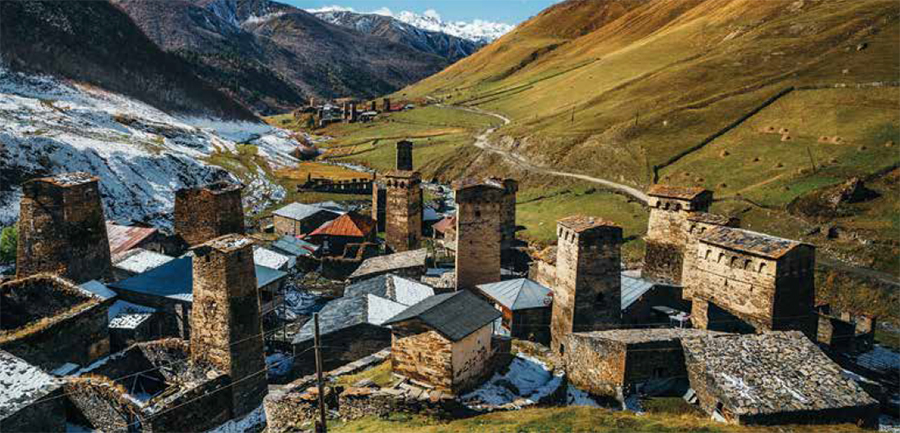
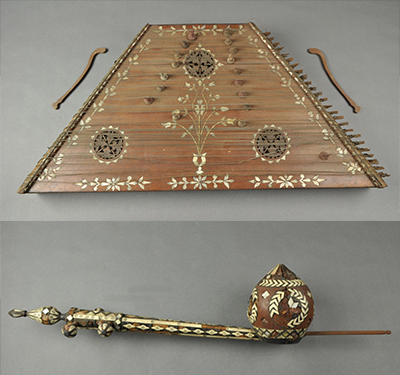
To investigate these questions, in 2012, our research team initiated fieldwork in Svaneti to obtain genetic, genealogical, and historical information about Svan individuals living there. The team consisted of Dr. Aram Yardumian, then a doctoral student in the Department of Anthropology at Penn (now Assistant Professor at Bryn Athyn College); Dr. Ramaz Shengelia, Professor of Medicine from Tbilisi State Medical University; and Dr. David Chitanava, Dr. Shorena Laliashvili, and Irma Laliashvili from the Ivane Javakhishvili Institute of History and Ethnology in Georgia. Two other members of the team, Dr. Lia Bitadze, a physical anthropologist from the Ivane Javakhishvili Institute of History and Ethnology; and Dr. Theodore Schurr, Professor of Anthropology at Penn and the Director of the Laboratory of Molecular Anthropology, did not participate in the field research, although Schurr did direct the laboratory analysis of Svan DNA samples.
Conducting Genetic Research in Svaneti

Our team spent two weeks traveling through the region, enrolling and sampling 184 Svan individuals from 13 village districts and townlets located throughout Upper Svaneti. We sought out individuals having different surnames and clan affiliations to gain as broad a representation of genetic diversity as possible. We also conducted interviews with participants about their genealogies and knowledge of local history, as this information was crucial for the interpretation of the genetic data. Participants identified their age and birthplace; their parents’ names, ethnicity, and birthplaces (when known); and their four grandparents’ names, ethnicities, and birthplaces (when known). In some cases, extensive family trees, kept in private homes, were brought out of storage for our review.
How did we do all of this? One cannot simply walk into a region as fiercely independent, culturally traditionalist, and potentially hazardous as Svaneti and go door-to-door asking to swab people’s cheeks. On the libertarian scale, Svaneti falls somewhere between the Ozarks and Pakistan’s Northwest Frontier Province.
There was also the matter of obtaining official permission to do this kind of work in Svaneti. As with all such matters in Georgia and the rest of the post Soviet world, official permissions are complicated and frustrating to obtain. Dr. Shengelia contacted Adilar Chartolani, a family friend who now lives in Mestia. Chartolani in turn arranged for a meeting with Ilia Japaridze, the mayor of Mestia. After several meetings with the mayor, he gave us a list of 12 of his deputies and their cell phone numbers. These deputies in turn made calls to remote homesteads within the village districts to see who was willing to participate in this study.
Thanks to this unprecedented access, we were able to reach individuals in village districts like Laghani, Mulakhi, Ipari, Kala, and Ushguli. In fact, we arrived in Ushguli in the middle of the Livskhvari Festival, which is celebrated on the first Sunday of August, marking the start of the grass-cutting season (fodder for cattle). Here, we encountered some friction based on rumors that we were agents of the central government there to collect DNA from the families of local criminal gangs. One man—presumably with a colorful past—even went running and dove over a wall to get away from us. Because of this concern and the atmosphere of the festival, we managed to enroll only a handful of persons in the study.
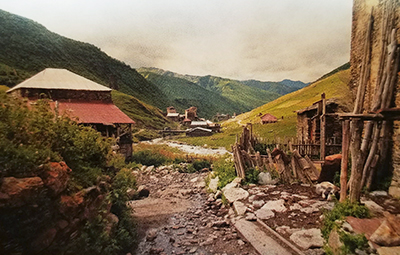
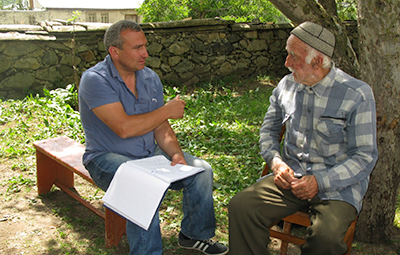
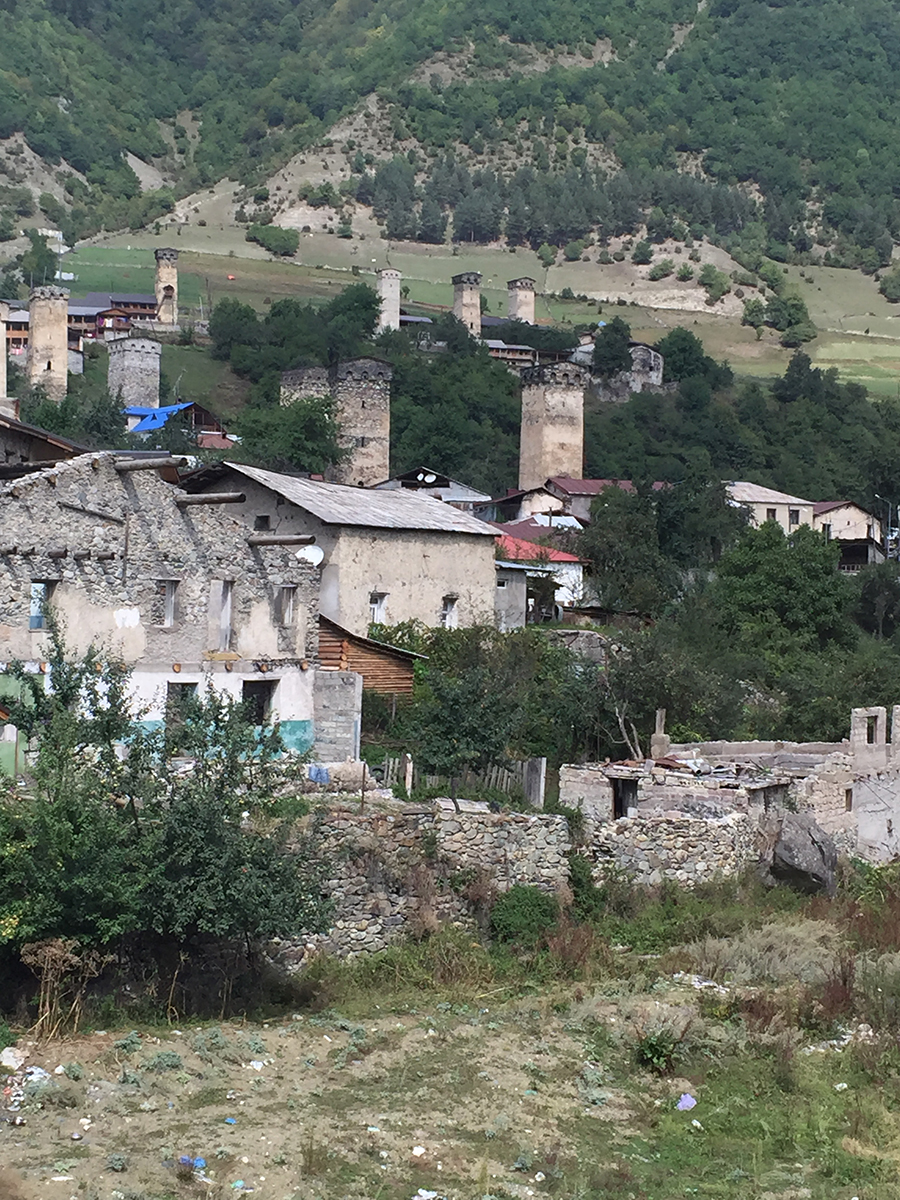
Analysis Reveals Genetic Diversity
Upon completion of the fieldwork in Svaneti, Aram Yardumian returned to Penn with the Svan DNA samples to be analyzed for genetic variation in the Laboratory of Molecular Anthropology. Penn undergraduates Andrew Azzam, Kristi Edleson, and Akiva Sanders; high school intern Victoria Groner; post-doctoral fellow Miguel Vilar; and Dr. Schurr undertook the genetic analysis of Svan DNA samples. This analysis focused on the mitochondrial DNA (mtDNA), which reveals information about female genetic lineages, and the Y-chromosome (NRY), which reveals information about male genetic lineages.
Our genetic results provided new insights into Svan and Georgian population history (see citations below). Svans exhibited a great diversity of mtDNA lineages (H, I, J, K, U1–U7, M1, R0a1, N1b1, T, X2, W6), with the majority being of putative West Eurasian or Near Eastern origin. We also found low frequencies of East Eurasian lineages (C and D), ones likely brought to the Caucasus by expanding Turkic or Mongolic populations. Interestingly, many of these maternal lineages were shared not only between the North and South Caucasus, but also with Anatolian, Iranian, and other Near Eastern populations. The greater movement of women between highland Caucasus regions due to bride theft, patrilocality, and other cultural processes that traditionally restricted male, but encouraged female, gene flow may have contributed to this pattern of diversity.
From a Y-chromosome perspective, Svans had far fewer lineages (G2a, I2, J2a, N, R1a), with one (G2a) being present in 80% of Svan men. Interestingly, G2a showed great haplotype (sublineage) diversity, suggesting either a great antiquity for this lineage in the region or considerable interregional gene flow in the South Caucasus. Geographically speaking, G2a is found in eastern Anatolia, the Caucasus, and Iran, while R1a may have its roots in the Pontic steppe region, J2a in the Near East, I2 in eastern and central Europe (Balkans), and N in eastern Eurasia. These contrasting results attest to a complex set of geographic sources and pre- and proto-historic settlement epochs shaping the ethnogenesis of Svans.
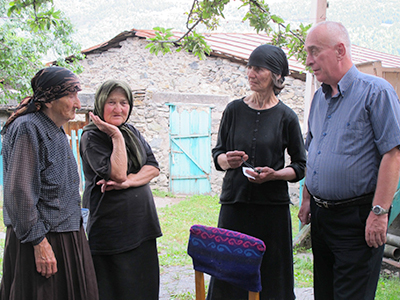
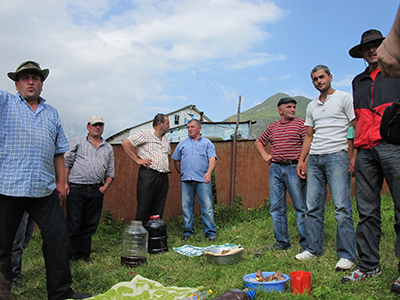
On a broader level, our data revealed some genetic similarities between Svans and neighboring Ossetian, Adyghe, and Abkhaz (non-Kartvelian-speaking) populations, but also distinct patterns of mtDNA and Y-chromosome variation among them. We also noted general genetic affinities between Svans and other Georgians. These findings suggested that geography is more influential than language or culture on patterns of genetic variation in this region. Furthermore, our analysis indicates that the lineage frequencies observed in these populations were established well before the emergence of any of these languages or ethnic identities.
The mosaic pattern of ethnic and regional identity in the Caucasus, as well as other former Soviet regions, is complex and reflects processes of settlement and sovereignty going back centuries. Small regional conflicts within this mosaic have routinely been harnessed and used to leverage influence in the territorial games played by small and great powers.
In fact, ethnic divisions in the Caucasus have never looked sharper and more nationalistically defined than they do now in the post-Soviet period. While neighboring powers wage battles, both soft and violent, for regional influence, local peoples struggle to maintain their autonomy and traditions. In spite of these tensions, however, biological arguments rarely enter explicitly into the rhetoric and reasoning behind the conflicts in Georgia as they did in Yugoslavia and Apartheid South Africa. Given our research into Caucasus populations, such reasoning has no logical basis. The patterns of diversity between and within Caucasus populations, including Svans, point to a shared heritage deep in human history that provides a bulwark against intolerant tendencies, as based on the supposed biological uniqueness and character of nations.
While being the first anthropological genetic survey to be undertaken in Svaneti, this project also represents the beginning of a comprehensive study of genetic variation in Georgia (the Georgia Genetic History Project) that will situate its history more firmly within the broader context of the Caucasus and Near East. Eventually, we will be in a position to assess the extent to which Georgians are the genetic descendants of Bronze Age (e.g. Kura-Araxes), Neolithic, or even Upper Paleolithic settlers in the region. This approach will further result in a better comparative understanding of Georgian and South Caucasus population history and the formation of identities in these regions.
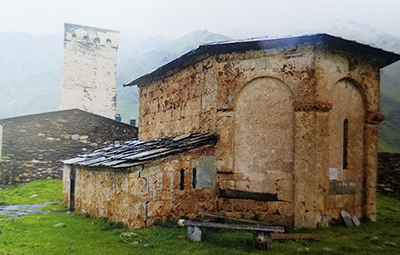
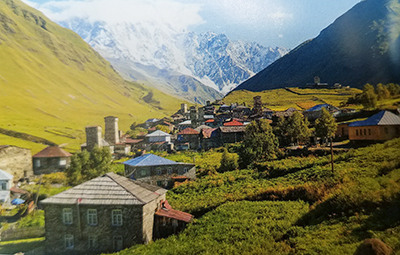
Acknowledgments
We wish to express our gratitude to the people of Svaneti for their hospitality and participation in this study. We would also like to acknowledge the organizations that provided administrative and logistical support for this project. These include the University of Pennsylvania Museum of Archaeology and Anthropology, the University of Pennsylvania Department of Anthropology, Tbilisi State Medical University, Ivane Javakhishvili Institute of History and Ethnology, the Georgian National Council on Bioethics, the Georgian Academy of Sciences, and the Penn IRB #8. In addition, we would also like to thank Ilya Japaridze, mayor of Mestia, for his facilitation of our work in remote Svan communities, and Adilar and Zaur Chartolani for assistance with logistics in Svaneti. We also would like to thank Dr. Kevin Tuite of the Université de Montréal for information about Svan linguistics. We received financial support for this project from the National Science Foundation (BCS-1249281), the University of Pennsylvania Museum of Archaeology and Anthropology, the University of Pennsylvania Department of Anthropology, the American Philosophical Society, and Penn Faculty Research Funds.
For Further Reading
Deeters G. Das Karthwelische Verbum. Vergleichende Darstellung des Verbalbaus der südkaukasischen Sprachen. Sächsische Forschungsinstitute Leipzig. Forschungsinstitut für Indogermanistik, Sprachwissenschaftliche Abteilung. Band 1. Leipzig: Merkert & Petters, 1930.
Klimov G.A. Die kaukasische Sprachen. Tr. by Boeder W. Hamburg: H. Buske Verlag, 1969.
Klimov G.A. Einführung in die kaukasische Sprachwissenschaft. Tr. By Gippert J. Berlin: Buske, 1994.
Nichols J. “The Origin and Dispersal of Languages: Linguistic Evidence,” in The Origin and Diversification of Language, edited by N.G. Jablonski and L. Aiello. San Francisco: California Academy of Sciences, 1998.
Pliny the Elder. The Natural History. Loeb Classical Library. Vol. II. London: W. Heinemann, 1938.
Schurr T.G., A. Yardumian, R. Shengelia, L. Bitadze, D. Chitanava, S. Laliashvili, I. Laliashvili, A. Sanders, A. Azzam, V. Groner, K. Edleson, and M. Vilar. 2015. “Genetic Diversity and Population History in Svaneti, Northwestern Georgia.” Caucasiologic Papers 7: 319-336.
Strabo. Geography, edited by H.L. Jones. Cambridge: Harvard University Press, 1924.
Tuite K. “The Svans,” in The Encyclopedia of World Cultures. Vol. 6., edited by P. Friedrich, N. Diamond, and D. Levinson, pp. 343–47. Boston: GK Hall & Sons, 1994.
Yardumian A., R. Shengelia, L. Bitadze, D. Chitanava, S. Laliashvili, I. Laliashvili, A. Sanders, A. Azzam, V. Groner, K. Edleson, M.G. Vilar, and T.G. Schurr. “Historical and Cultural Influences on Genetic Diversity in Svaneti, Northwest Georgia.” American Journal of Physical Anthropology, in review.
